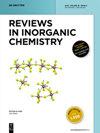Ruthenium complexes for breast cancer therapy
IF 3.1
3区 化学
Q1 CHEMISTRY, INORGANIC & NUCLEAR
引用次数: 1
Abstract
Abstract Breast cancer cells have long been inhibited by polypyridine Ru(II) complexes, which are excellent antitumor agents. Due to their multi-targeting properties, this class of ruthenium complexes has received increasing attention as anticancer drug candidates approach to various cellular targets. The aim of this review is to give information about the ligands that were carefully chosen for ruthenium complexes. There has been a great deal of interest in using ruthenium-based complexes to treat breast cancer. Several species have shown potential as treatment candidates. However, further research is needed to determine how these agents affect the metastatic potential of breast cancer cells. The mechanism of action of Ru-based anticancer candidates NAMI-A and KP1019 during phase I clinical trials has been discussed. This article explains hormone-positive breast cancer and triple-negative breast-cancer treatment by using Ru complexes. Although platinum (Pt-based) anticancer medication is widely used in cancer treatment, a minor improvement has been seen and that is Platinum replaced with Ruthenium for its anticancer properties. We have also highlighted the best effective ruthenium-based complexes in treating T.N.B.C. (triple-negative breast cancer) here in this collection.钌配合物用于乳腺癌治疗
多吡啶Ru(II)络合物是一种优良的抗肿瘤药物,长期以来一直对乳腺癌细胞有抑制作用。由于其多靶点特性,这类钌配合物越来越受到关注,作为抗癌候选药物接近各种细胞靶点。本综述的目的是提供有关为钌配合物精心选择的配体的信息。人们对使用钌基复合物治疗乳腺癌非常感兴趣。一些物种显示出潜在的治疗候选者。然而,需要进一步的研究来确定这些药物如何影响乳腺癌细胞的转移潜力。本文讨论了基于ru的抗癌候选药物NAMI-A和KP1019在I期临床试验中的作用机制。本文介绍了Ru复合物治疗激素阳性乳腺癌和三阴性乳腺癌的方法。虽然铂(基于pt的)抗癌药物广泛用于癌症治疗,但已经看到了一个微小的改进,那就是铂被钌取代,因为它具有抗癌特性。我们还在本系列中强调了治疗三阴性乳腺癌最有效的钌基复合物。
本文章由计算机程序翻译,如有差异,请以英文原文为准。
求助全文
约1分钟内获得全文
求助全文
来源期刊

Reviews in Inorganic Chemistry
化学-分析化学
CiteScore
7.30
自引率
4.90%
发文量
20
审稿时长
1 months
期刊介绍:
Reviews in Inorganic Chemistry (REVIC) is a quarterly, peer-reviewed journal that focuses on developments in inorganic chemistry. Technical reviews offer detailed synthesis protocols, reviews of methodology and descriptions of apparatus. Topics are treated from a synthetic, theoretical, or analytical perspective. The editors and the publisher are committed to high quality standards and rapid handling of the review and publication process. The journal publishes all aspects of solid-state, molecular and surface chemistry. Topics may be treated from a synthetic, theoretical, or analytical perspective. The editors and the publisher are commited to high quality standards and rapid handling of the review and publication process.
Topics:
-Main group chemistry-
Transition metal chemistry-
Coordination chemistry-
Organometallic chemistry-
Catalysis-
Bioinorganic chemistry-
Supramolecular chemistry-
Ionic liquids
 求助内容:
求助内容: 应助结果提醒方式:
应助结果提醒方式:


